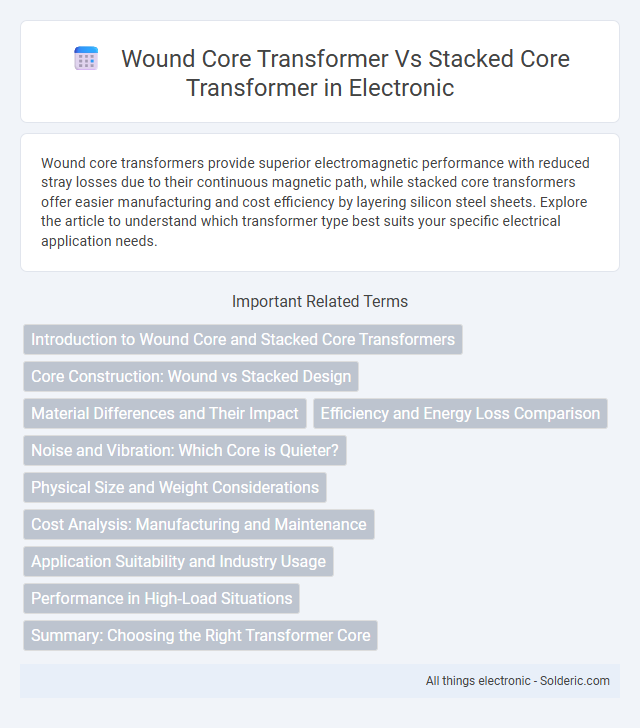Wound core transformers provide superior electromagnetic performance with reduced stray losses due to their continuous magnetic path, while stacked core transformers offer easier manufacturing and cost efficiency by layering silicon steel sheets. Explore the article to understand which transformer type best suits your specific electrical application needs.
Comparison Table
| Feature | Wound Core Transformer | Stacked Core Transformer |
|---|---|---|
| Core Construction | Core made by winding grain-oriented steel strips. | Core assembled by stacking thin steel laminations. |
| Magnetic Properties | Higher magnetic flux density, lower core loss. | Moderate magnetic flux density, higher core loss. |
| Efficiency | Higher efficiency due to reduced losses. | Lower efficiency with increased hysteresis losses. |
| Manufacturing Complexity | More complex, requires precision winding. | Simpler manufacturing process. |
| Cost | Generally higher cost. | Lower cost, economical for mass production. |
| Applications | High-performance transformers, power supplies. | General purpose transformers, lower power ratings. |
| Noise & Vibrations | Lower audible noise due to core design. | Higher vibrations and noise levels. |
Introduction to Wound Core and Stacked Core Transformers
Wound core transformers feature a continuous strip of magnetic steel wound into a coil, reducing losses and improving efficiency through a uniform magnetic path. Stacked core transformers consist of laminated steel sheets stacked together, offering ease of manufacturing and cost-effectiveness but potentially higher core losses due to air gaps. Understanding the differences helps you choose the right transformer type for your specific electrical application and efficiency requirements.
Core Construction: Wound vs Stacked Design
Wound core transformers feature a core constructed by tightly winding thin magnetic steel strips into a continuous coil, reducing core losses and enhancing magnetic flux uniformity. In contrast, stacked core transformers utilize layers of laminated steel sheets stacked together, offering simplified manufacturing but potentially higher eddy current losses due to less compact magnetic paths. The wound design generally provides improved efficiency and reduced noise, making it ideal for precision applications where core performance is critical.
Material Differences and Their Impact
Wound core transformers feature a continuous strip of grain-oriented silicon steel shaped into a coil, minimizing magnetic losses and enabling higher efficiency in reducing core noise. Stacked core transformers consist of multiple stamped steel laminations stacked together, which can introduce increased eddy current losses and slightly higher hysteresis losses due to interlaminar resistance. The material continuity in wound cores leads to superior magnetic flux path smoothness, resulting in better performance in applications demanding low noise and high efficiency compared to the segmented structure of stacked cores.
Efficiency and Energy Loss Comparison
Wound core transformers exhibit higher efficiency due to their continuous magnetic path, which reduces eddy current losses and minimizes energy dissipation compared to stacked core transformers. Stacked core transformers suffer from increased energy loss caused by air gaps and laminations, leading to higher hysteresis and eddy current losses. Your choice of transformer impacts overall energy efficiency, with wound core designs preferable for applications demanding lower energy loss and improved performance.
Noise and Vibration: Which Core is Quieter?
Wound core transformers typically generate less noise and vibration compared to stacked core transformers due to their continuous magnetic path, which reduces flux leakage and minimizes magnetostriction effects. The compact, uniform winding structure in wound cores contributes to quieter operation, making them ideal for noise-sensitive applications. If low noise is a priority for your electrical setup, choosing a wound core transformer can significantly enhance acoustic performance.
Physical Size and Weight Considerations
Wound core transformers typically have a more compact and lighter design because their cores are formed by winding thin steel strips, reducing material bulk compared to stacked core transformers that use layered laminations. Stacked core transformers often result in a larger physical size and increased weight due to the multiple steel lamination layers stacked to create the core. When considering your applications, choosing a wound core transformer can optimize space and reduce weight constraints in tight or weight-sensitive environments.
Cost Analysis: Manufacturing and Maintenance
Wound core transformers generally have higher manufacturing costs due to the intricate winding process that requires specialized equipment and skilled labor, whereas stacked core transformers benefit from simpler assembly using laminated steel sheets, reducing initial expenses. Maintenance costs for wound core transformers may be elevated because their compact design complicates inspection and repair, while stacked core transformers allow easier access to components, facilitating lower maintenance efforts and costs. Your choice should consider both upfront manufacturing investments and long-term maintenance implications to optimize overall cost-effectiveness.
Application Suitability and Industry Usage
Wound core transformers excel in applications requiring low noise and minimal electromagnetic interference, making them ideal for audio equipment, medical devices, and precision instrumentation. Stacked core transformers are preferred in high-power industrial settings such as power distribution and heavy machinery due to their robustness and ease of manufacturing. The choice between wound core and stacked core transformers depends on specific industry demands for efficiency, noise levels, and mechanical durability.
Performance in High-Load Situations
Wound core transformers deliver superior performance in high-load situations due to their enhanced magnetic flux distribution, which reduces core saturation and minimizes energy losses. Stacked core transformers, while simpler to manufacture, often experience higher eddy current losses and increased heat generation under heavy loads, limiting their efficiency and operational stability. The robust design of wound core transformers ensures better voltage regulation and longevity when subjected to continuous high-power demands.
Summary: Choosing the Right Transformer Core
Wound core transformers feature a continuous magnetic path formed by winding thin steel strips, reducing eddy current losses and enhancing efficiency in high-frequency applications. Stacked core transformers utilize laminated steel sheets stacked to construct the magnetic path, offering cost-effective solutions for low-frequency and power distribution purposes. Selecting the appropriate transformer core depends on factors such as operating frequency, efficiency requirements, cost constraints, and application-specific performance needs.
wound core transformer vs stacked core transformer Infographic

 solderic.com
solderic.com